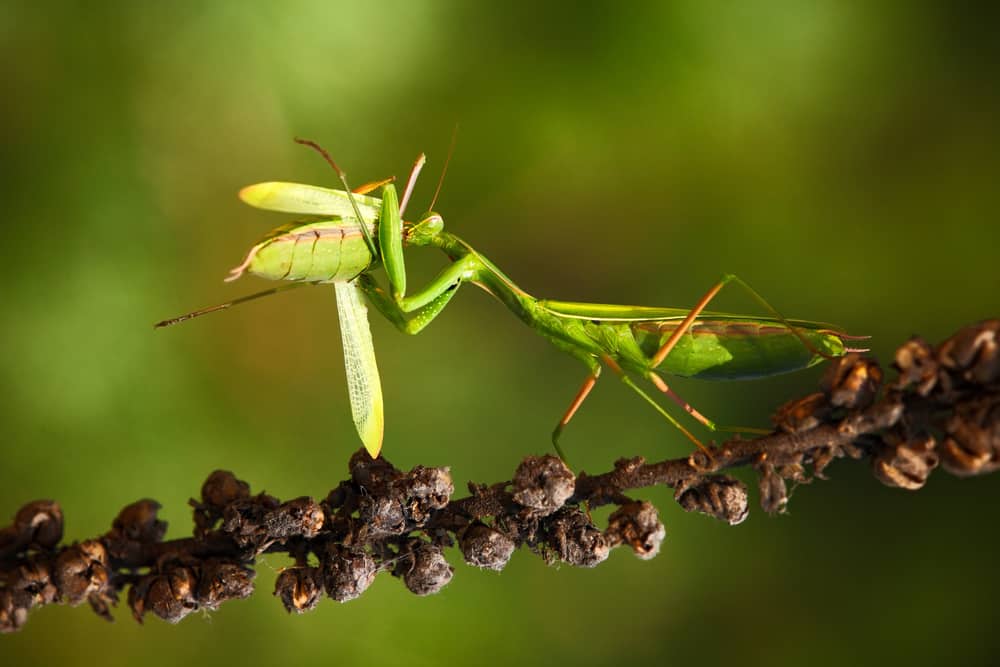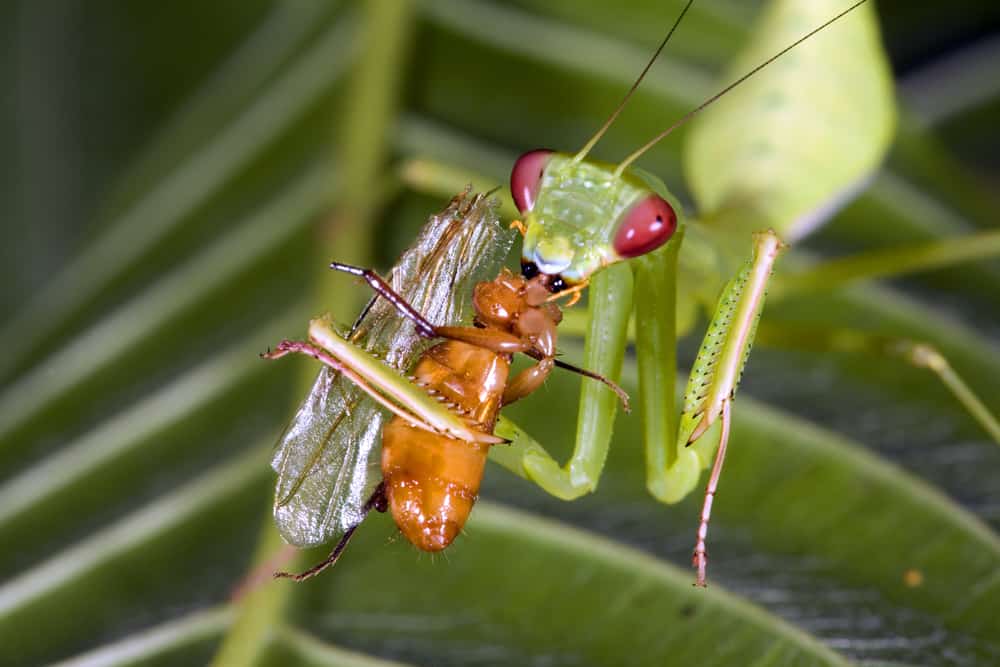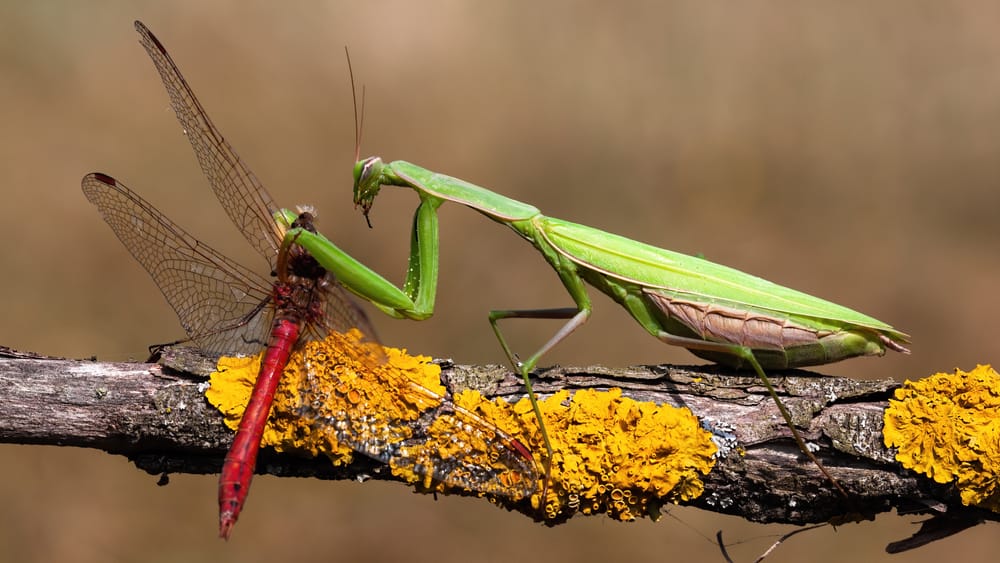Which is the utmost religious animal in the kingdom? The mantis. Why? Because it is always praying.
Praying mantises are famed for their stature that resembles that of a person praying. But despite being insects, they are also one of the best hunters in the animal kingdom. So, what do praying mantises like to eat most?
Praying Mantis Habits And Biology
Mantises or mantids are members of the order Mantidea of insects. There are more than 2,400 species. Praying mantis holds the more significant share of the family Mantidae.
Mantids have triangular heads with bulging eyes on flexible necks. All mantids possess elongated legs adapted for catching and gripping onto prey.
They use their raptorial legs to snare their victims swiftly. Mantids’ front legs have rows of spines that help them hold prey as they mutilate them, usually eating their heads first.
They are famed for their upright stationary posture, which resembles a praying person. Hence, the name ‘praying mantis.
A majority of mantids are known as ‘ambush predators,’ though a number of the ground-dwelling species are notorious for actively pursuing their prey.
Female mantids are significantly larger than their male counterparts. They have a particular practice that involves feeding off males before, during, or after mating. The practice is called sexual cannibalism.
Engaging in sex cannibalism helps them replenish the energy used up during the process. The female mantid gains nutrients that keep her from hunting after she mates.
Furthermore, it provides the female with resources for faster production of large eggs that increase the chances for her eggs to survive.
Moreover, mantids bear antennas on their heads that they use for sniffing out suitable prey. They go for warm, natural habitats that have long grasses and various shrubs and bushes.
The cover of these long grasses keeps them hidden against their predators and prey, allowing them to ambush their prey easily.
Did you know mantids have only one ear? Its found in their under-bellies, meaning it is unable to distinguish sound direction.
However, the adaptation allows them to detect ultrasound produced by bats. Ultrasound helps them avoid bats that are considered their number one predator. Detection of ultrasounds also enables them to hunt effectively.
What Do Praying Mantises Like To Eat Most?
Praying mantises are mainly carnivores. Therefore, their diets are primarily protein-rich. Mantids are accomplished (apex) hunters. They are known to take on anything from grasshoppers to frogs.
Mantids are also biotrophs, meaning they can consume both carnivorous anthropods (insects) and herbivores.
With their camouflaged bodies, razor-sharp forelimbs, and heads that can rotate to up to 180o, these insects are fearless and can take on the most formidable prey. Here are some of the foods mantids like to eat most:
- Spiders –tiny spiders act as a good food source though some may bite the mantid before it’s eaten.
- Crickets –provide a staple diet for mantises but can also prove harmful as they may also harm the mantid before consumption.
- Frogs –are both prey and predators of mantids. The bigger the mantid, the greater the chances it has to subdue and consume the frog.
- Mosquitoes –are easy to hunt for mantids and pose no threat during consumption.
- Cockroaches –are easily consumed by mantids of all sizes and provide a staple meal, especially for young mantids.
- Bees may pose a slight threat during consumption as they may attempt to sting the mantis, rendering the mantid dead or seriously injured.
- Butterflies –mantids are attracted to gardens by flowers just as butterflies, and hence they provide a staple diet for garden dwelling mantids.
- Hummingbirds –large mantids are capable of subduing these species of birds and eating them.
- Beetles –like birds are both predators and prey of mantids depending on the size of either of the insects.
- Grasshoppers
- Lizards
- Caterpillars
- Rodents
- In times of scarcity, they may prey and feed on their species as well.
Their size typically determines mantids’ diets. Larger mantids possess the capability to hunt and consume larger prey.
Foods Avoid feeding Praying Mantis
Despite being apex predators, mantids are also limited. The irony lies in what they feed. Sometimes what they eat is what might kill them. They are also victims of a lot of parasites.
Below are some of the prey items that are harmful to praying mantises:
- Depending on the size, mantids are vulnerable than larger prey such as frogs or even spiders.
- Poisonous insects –such as bees or spiders that possess a lethal sting, may succeed in subduing the mantis using their poison.
- A bee, for example, may sting the mantis before it’s devoured, ultimately killing the mantis.
- Wasps such as the Mantidophaga and Podagrion are known to feed on mantids eggs.
- Mantidophaga is both a parasite in adult and larval stages and lives inside the mantis egg cases. The adult parasites reside on the mantids in groups of approximately five.
- After the eggs of the Mantidophaga (wasps) hatch, they fly off to find a new host. In this case, the host is the adult mantid. Afterward, the wasps tear the wings of the mantis off as it doesn’t plan on ever leaving the host.
- The wasps’ host can either be male or female as it can also shift hosts when it pleases.
- These wasps solely feed on the mantis’ blood as it awaits for the mantis to lay her eggs.
- Other species of wasp, such as the Torymid wasp, thrive on mantids egg cases. They target mantid eggs because their eggs resemble the gall wasp, which is also their prey.
- The Masiphya species of flies are known to live off mantids, especially those of the Tachinidae
- The mother fly implants its eggs into the mantids underbelly, and it settles in the abdomen, where it constructs a respiratory funnel (passageway for air).
- It feeds on the mantids’ blood for some time before it digs out and continues its life cycle.
Even these formidable hunters have a weakness like all other animals. Take note of the above when feeding or caring for mantids.
Tips To Feeding Praying Mantises
Praying mantises are easy to care for and enjoyable to have as pets. Notwithstanding, it’s still essential to care for and feed them correctly when in captivity. Otherwise, they may fall prey to parasites or die prematurely.
Please consider the following factors before feeding your pet mantids:
- Feed your mantids two live insects every other day as they don’t need to eat daily. Mantids don’t eat dead prey items.
- Adult females may need to feed more to provide essential nutrients necessary for egg production.
- For recently hatched mantids, feed them fruit flies or gnats (small flying insects). You can purchase fruit flies online or in pet shops that sell reptile foods.
- Alternatively, you can attract fruit flies using fruit.
- Determine the size of your mantids’ food based on the size of their forearms for older insects.
- Smaller or adolescent mantids can feed on smaller prey items such as roaches or crickets. As they mature or grow larger, consider providing them with more oversized prey items.
- Keep an eye out as your mantids eat to ensure their food doesn’t escape. Roaches and caterpillars tend to hide.
- Hold the food in place using tweezers or any suitable substitute to encourage the mantids to feed immediately.
- Take out any insects your mantids neglect to eat –dispose of any animal tidbits left in your mantids’ enclosure to keep their environment clean.
These simple steps will allow your pet mantids to flourish throughout their one-year lifespan when put into consideration.
Frequently Asked Questions
Can praying mantises spit and bite you?
During your childhood, you may have heard stories about mantids being able to spit poison in your eyes if you stare at them.
Contrary to popular belief, these were just tales told to children to discourage them from playing with the insects. Mantids don’t spit, and neither are they poisonous.
Stick insects, at times, mistaken for praying mantises discharge a spray as a means of defense when threatened. Mantids may bite when threatened but are typically harmless to human beings.
What does it mean when you see many praying mantises?
Different religions and cultures share different views. Some consider them to be a bad omen, and others differ in opinion. To most people, mantises are a symbol of good luck. Seeing them may bring luck your way.
Generally, mantises also symbolize focus, calmness, and concentration. Their characteristic green or brown color symbolizes the earth and also peace and harmony with nature.
What action can you take when you see a praying mantis in your house?
The simplest way to rid your house of a mantis is simply by picking it up, placing it in a box, and releasing it in another location.
Gently place the mantis inside the box and cover it with a lid. Slowly pick up the box containing the mantis and release it to another location.
If able to, be careful while handling the mantis to prevent harming the creature. You can put on gloves or use tweezers if it gets aggressive to avoid minor scratches or bites.
Summary
These ‘religious’ insects may appear innocent due to their natural stature, but don’t be fooled.
Praying mantises are among the most ruthless hunters in the animal kingdom, with patience as a virtue paired with razor-sharp forelimbs and super fast striking abilities.



Tremendous! Her certainly tremendous write-up, May very well gained a lot of clean theory concerning the main topics designed by section.